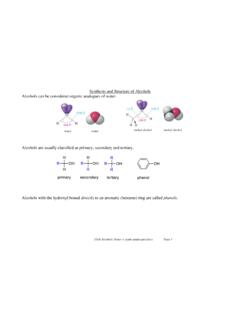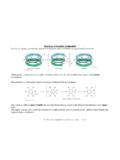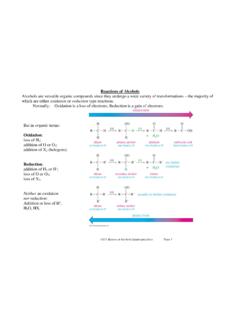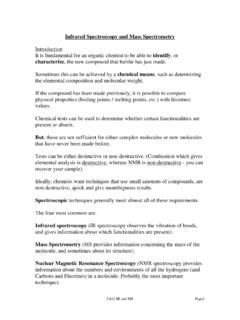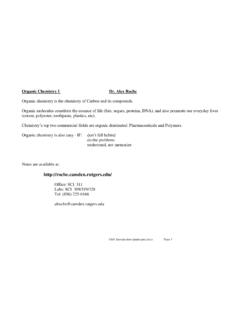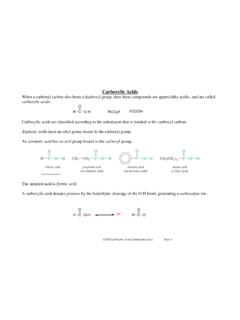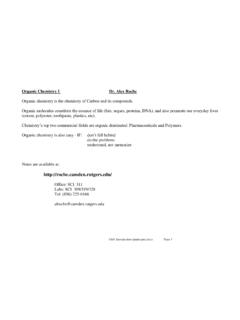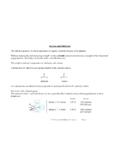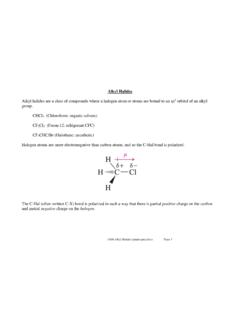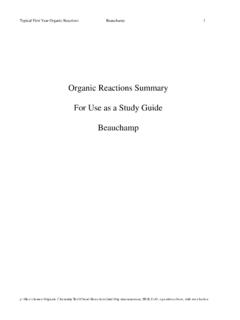Transcription of Ketones and Aldehydes - Rutgers University
1 Ch18 Ketones and Aldehydes (landscape) Page 1 Ketones and Aldehydes The carbonyl group is of central importance in organic chemistry because of its ubiquity. Without studying the carbonyl group in depth we have already encountered numerous examples of this functional group ( Ketones , Aldehydes , carboxylic acids, acid chlorides, etc). The simplest carbonyl compounds are Aldehydes and Ketones . A ketone has two alkyl (or aryl) groups bonded to the carbonyl carbon. An aldehyde has one alkyl (or aryl) group and one hydrogen bonded to the carbonyl carbon. Structure of the carbonyl group The carbonyl carbon is sp2 hybridized, and has a partially filled unhybridized p orbital perpendicular to the framework. RCHORCRO aldehydeketone Ch18 Ketones and Aldehydes (landscape) Page 2 The oxygen is also sp2 hybridized, with the 2 lone pairs occupying sp2 orbitals. This leaves one electron in a p orbital. These p orbitals form the carbon oxygen bond. The C=O double bond is like a C=C double bond except the carbonyl double bond is shorter and stronger.
2 The carbonyl group has a large dipole moment due to the polarity of the double bond. Oxygen is more electronegative than carbon, and so the bond is polarized toward the oxygen. The attraction of the weakly held electrons toward oxygen can be represented by the two following resonance structures. The first resonance structure is the major contributor, but the other contributes in a small amount, which helps explain the dipole moment. It is this polarization that creates the reactivity of the carbonyl groups (carbon is electrophilic/LA, and the oxygen is nucleophilic/LB). Ch18 Ketones and Aldehydes (landscape) Page 3 Nomenclature IUPAC nomenclature requires Ketones to be named by replacing the -e ending of the alkyl name with -one. Alkane alkanone Ch18 Ketones and Aldehydes (landscape) Page 4 Systematic names for Aldehydes are obtained by replacing -e with -al. An aldehyde has to be at the end of a chain, and therefore it is carbon number 1. If the aldehyde is attached to a large unit, the suffix -carbaldehyde is used.
3 CH3 CHOH3 CCH2 CHCHCHO ethanalpent-2-enalCHOcyclohexanecarbalde hyde Ch18 Ketones and Aldehydes (landscape) Page 5 A ketone or aldehyde group can also be named as a substituent on a molecule with another functional group as its root. The ketone carbonyl is given the prefix oxo-, and the aldehyde group is named as a formyl- group. (This is especially common for carboxylic acids). Common Names The wide spread use of carbonyl compounds means many common names are entrenched in their everyday use. H3 CCCH3 OacetoneCOCH3acetophenoneCObenzophenone Ch18 Ketones and Aldehydes (landscape) Page 6 Syntheses of the Aldehydes and Ketones (Recap?) From Alcohols (Ch 11) Secondary alcohols are readily oxidized to Ketones by Chromic acid (or KmnO4). Complicated Ketones can be made by the oxidation of alcohols, which in turn can be made from reaction of a Grignard and an aldehyde. Aldehydes are made from the oxidation of primary alcohols. This oxidation needs to be done carefully to avoid overoxidation to carboxylic acids.
4 This is achieved by the use of PCC. Ch18 Ketones and Aldehydes (landscape) Page 7 Ozonolysis (Ch 8) alkenes can be cleaved by ozone (followed by a mild reduction) to generate Aldehydes and/or Ketones . Phenyl Ketones and Aldehydes (Ch 17) Friedal Crafts acylation is an excellent method for the preparation of alkyl aryl Ketones . The Gatterman-Koch reaction produces benzaldehyde systems. Ch18 Ketones and Aldehydes (landscape) Page 8 Hydration of Alkynes (Ch 9) Hydration of alkynes can either be achieved with Markovnikov (acid and mercury (II) catalyzed reaction) or anti-Markovnikov (hydroboration-oxidation) regiochemistry. In both cases the enols produced rearrange to their more stable keto forms (in the hydroboration case the keto form is an aldehyde). Ch18 Ketones and Aldehydes (landscape) Page 9 Other Syntheses of Aldehydes and Ketones Use of 1,3-Dithiane Dithiane has relatively acidic hydrogens located between the two sulfur atoms, and these can be removed by a strong base.
5 The anion is stabilized by the electron withdrawing effect of the highly polarizable sulfur atoms. The dithiane anion can react as a nucleophile with primary alkyl halides, and this alkylation generates a thioacetal. The hydrolysis of a thioacetal generates an aldehyde. Alternatively, the thioacetal can be further deprotonated and reacted with another (different) alkyl halide to generate a new thioacetal with two alkyl substituents. On hydrolysis, this thioacetal produces a ketone . Ch18 Ketones and Aldehydes (landscape) Page 10 This is a good route for the construction of unsymmetrical Ketones . The dithiane can be thought of as a "masked" carbonyl group. Ketones from Carboxylic Acids Organolithium reagents are very reactive towards carbonyl compounds. So much so, that they even attack the lithium salts of carboxylate anions. These dianions can then be protonated, which generates hydrates, which then lose water and produce Ketones . Ch18 Ketones and Aldehydes (landscape) Page 11 If the organolithium reagent is not expensive, then the carboxylic acid can be simply treated with two equivalents of the organolithium.
6 The first equivalent just deprotonates the carboxylic acid. (expensive base!) Ketones from Nitriles Nitrile compounds contain the cyano group (carbon nitrogen triple bond). Since N is more electronegative than C, the triple bond is polarized toward the nitrogen, (similar to the C=O bond). Therefore nucleophiles can attack the electrophilic carbon of the nitrile group. Grignard (or organolithium) reagents attack the nitrile to generate the magnesium (or lithium) salt of an imine. Acid hydrolysis generates the imine, and under these acidic conditions, the imine is hydrolyzed to a ketone . Ch18 Ketones and Aldehydes (landscape) Page 12 The mechanism of this hydrolysis is discussed in depth (for the reverse reaction) later. Aldehydes and Ketones from Acid Chlorides Aldehydes It is very difficult to reduce a carboxylic acid back to an aldehyde and to get the reduction to stop there. Aldehydes themselves are very easily reduced (more reactive than acids), and so almost always, over-reduction occurs.
7 Ch18 Ketones and Aldehydes (landscape) Page 13 However, to circumvent this problem, carboxylic acids can be converted first into a functional group that is easier to reduce than an aldehyde group. The group of choice is an acid chloride. The reaction of carboxylic acids with thionyl chloride (SOCl2) generates acid chlorides. Although strong reducing agents like LiAlH4 still reduce acid chlorides all the way to primary alcohols, milder reducing agents like lithium aluminum tri(tbutoxy)hydride can selectively reduce acid chlorides to Aldehydes . Ch18 Ketones and Aldehydes (landscape) Page 14 Ketones Acid chlorides react with Grignard (and organolithium) reagents. However the Ketones produced also react with the nucleophilic species, and tertiary alcohols are produced. To stop the reaction at the ketone stage, a weaker organometallic reagent is required - a lithium dialkylcuprate fits the bill. The lithium dialkyl cuprate is produced by the reaction of two equivalents of the organolithium reagent with copper (I) iodide.
8 2 R-Li + CuI R2 CuLi + LiI Ch18 Ketones and Aldehydes (landscape) Page 15 reactions of Aldehydes and Ketones The most common reaction of Aldehydes and Ketones is nucleophilic addition. This is usually the addition of a nucleophile and a proton across the C=O double bond. As the nucleophile attacks the carbonyl group, the carbon atom changes from sp2 to sp3. The electrons of the bond are pushed out onto the oxygen, generating an alkoxide anion. Protonation of this anion gives the final product. Ch18 Ketones and Aldehydes (landscape) Page 16 We have already encountered (at least) two examples of this: Grignards and Ketones tertiary alcohols Hydride sources and Ketones secondary alcohols These reactions are both with strong nucleophiles. Under acidic conditions, weaker nucleophiles such as water and alcohols can add. Ch18 Ketones and Aldehydes (landscape) Page 17 The carbonyl group is a weak base, and in acidic solution it can become protonated.
9 This makes the carbon very electrophilic (see resonance structures), and so it will react with poor nucleophiles. the acid catalyzed nucleophilic addition of water to acetone to produce the acetone hydrate. Ch18 Ketones and Aldehydes (landscape) Page 18 summary The base catalyzed addition reactions to carbonyl compounds result from initial attack of a strong nucleophile, whereas the acid catalyzed reactions begin with the protonation of the oxygen, followed by attack of the weaker nucleophile. Relative Reactivity Aldehydes are more reactive than Ketones . This (like all things in organic chemistry) stems from two factors: (1) electronics (2) sterics Ch18 Ketones and Aldehydes (landscape) Page 19 Electronic Effect Ketones have two alkyl substituents whereas Aldehydes only have one. Carbonyl compounds undergo reaction with nucleophiles because of the polarization of the C=O bond. Alkyl groups are electron donating, and so Ketones have their effective partial positive charge reduced more than Aldehydes (two alkyl substituents vs.)
10 One alkyl substituent). ( Aldehydes more reactive than Ketones ) Steric Reason The electrophilic carbon is the site that the nucleophile must approach for reaction to occur. In Ketones the two alkyl substituents create more steric hindrance than the single substituent that Aldehydes have. Therefore Ketones offer more steric resistance to nucleophilic attack. ( Aldehydes more reactive than Ketones ). Therefore both factors make Aldehydes more reactive than Ketones . Ch18 Ketones and Aldehydes (landscape) Page 20 Other reactions of Carbonyl Compounds Addition of Phosphorus Ylides (Wittig Reaction) In 1954 Wittig discovered that the addition of a phosphorus stabilized anion to a carbonyl compound did not generate an alcohol, but an alkene! (= Nobel prize in 1979). The phosphorus stabilized anion is called an YLIDE, which is a molecule that is overall neutral, but exists as a carbanion bound to a positively charged heteroatom. Ch18 Ketones and Aldehydes (landscape) Page 21 Phosphorus ylides are produced from the reaction of triphenylphosphine and alkyl halides.
